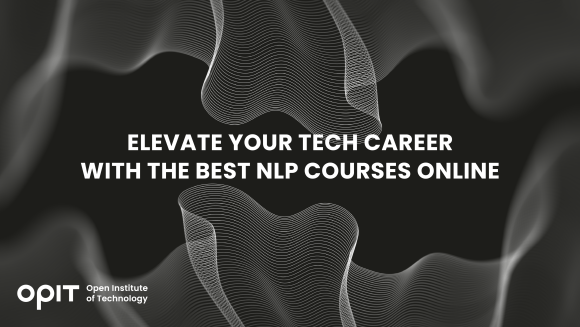

Natural language processing, or NLP for short, has been making waves for years, but as of late, it has caught the attention of even non-tech enthusiasts. Why is that? Simply put, natural language processing bridges human language and computer understanding to make interactions feel more natural and less like talking to machines.
For tech professionals, NLP skills have grown from “nice-to-have” status a few years ago to some of the most significant skills of the decade. The field is growing quickly, and many are interested in taking on the challenge. Luckily, many resources online can get you there and are flexible, in-depth, and practical.
Understanding Natural Language Processing
Natural language processing is an element of artificial intelligence (AI) that deals with the interaction between computers and humans using natural language.
Traditionally, human-computer interactions have largely been done through predefined commands within terminals or graphical user interfaces that obscure the “commands” behind graphical interactions. These interactions work well and aren’t going away. However, instructing a computer by “speaking” to it has been within the realm of science fiction for decades but has also been a research goal of many computer scientists for a long while.
The goal of natural language processing is to read, decipher, understand, and make sense of human language in a valuable way. Recently, it has been integrated into everything from search engines figuring out what users are searching for to translating languages on the fly. It’s even a part of predictive text that finishes sentences, particularly on mobile phone keyboards. Taking a course in NLP gives you a new skill for the CV that opens doors to many employment positions across sectors.
Choosing the Right NLP Course Online
When searching for the right NLP course, consider what you need. Specifically, focus on these:
- Curriculum
- Instructors
- Recognition
- Experience
Does the curriculum cover the latest in NLP technology? The field evolves fast, sometimes with several breakthroughs or at least advancements a year. Course material and curriculum that’s several years behind might miss some of the new developments.
Are the instructors seasoned professionals? The more experience one has in the field, the better equipped they are to pass that knowledge down.
Is the NLP course recognized by industry leaders? It isn’t a matter of appealing to authority but rather knowing that the course is of high enough quality to be considered valuable and useful.
And let’s not forget about the hands-on experience. You can’t really learn NLP just by reading about it. It would be best to try your hands in real-life projects and workshops.
Most NLP courses will walk you through the basics of machine learning, algorithms that power NLP, and hands-on projects that solidify your knowledge.
OPIT offers a full NLP course as a part of the Master of Science (MSc) in Responsible Artificial Intelligence program. The course gives you a solid theoretical foundation and plenty of hands-on experience, presented by instructors who are experts in the field. The degree teaches you how to use NLP and use it ethically and responsibly.
A List of the Best NLP Online Courses
Here are some standout NLP online courses:
- Coursera’s Natural Language Processing Specialization is for intermediate learners and spans over four months. It covers logistic regression, naive Bayes, word vectors, sentiment analysis, and more. The program is a comprehensive one that combines theory with practical assignments.
- Stanford Online’s Natural Language Processing with Deep Learning focuses on the cutting-edge intersection of NLP and deep learning. It’s an in-depth exploration of NLP’s fundamental concepts and its role in emerging technologies. This course is perfect for those looking to get a solid foundation in NLP from one of the leading institutions in the world.
- edX Natural Language Processing Courses & Programs: edX provides an intro to NLP that covers core techniques and computational linguistics. Topics include text processing, text mining, sentiment analysis, and topic modeling. It’s a great starting point for beginners and offers a broad overview of what NLP entails.
- DeepLearning.AI’s Natural Language Processing in TensorFlow on Coursera was designed by one of the pioneers in AI education. It offers practical insights into implementing NLP techniques using TensorFlow. The course covers processing text, representing sentences as vectors, and building NLP models.
- Udacity’s Natural Language Processing Nanodegree is project-focused with hands-on NLP learning. It covers foundational NLP concepts, including text processing, part-of-speech tagging, and sentiment analysis.
While these are the best natural language processing courses online, OPIT’s MSc in Responsible Artificial Intelligence, including NLP as part of its curriculum, is unique. This program teaches you NLP and embeds it within the broader context of artificial intelligence development, AI ethics, and responsible use. It’s excellent for those who want to go beyond the technical aspects and consider the societal impacts of their work in AI.
Benefits of Enrolling in an NLP Online Course
Attending an NLP course online might give you more than traditional on-site education. One of the biggest advantages is flexibility. You can learn at your own pace and on your schedule.
Online courses also open up networking opportunities with peers and mentors from around the globe. These are connections that on-site education would not have the scope to provide. Moreover, completing an NLP course can significantly boost your career prospects, potentially leading to job promotions and salary increases.
NLP Certification and Career Opportunities
With this certification, you’re proving your ability to understand and manipulate natural language data, making you invaluable in roles from data science and AI development to UX/UI design and content strategy.
Companies, from tech giants to startups, are on the lookout for professionals who can bridge the gap between human communication and machine understanding. The demand also translates into diverse job opportunities, competitive salaries, and the potential to work on groundbreaking projects in AI, machine learning, marketing, research, finance, and customer experience, among others.
Natural Machine Communication
NLP leads many of today’s technological advancements, making skills in this area more valuable than ever. Natural language processing courses that equip students with skills in natural language processing, AI, and related fields are growing in both offer and popularity. Completing one of these NLP courses sets you on a course for a financially promising career path within one of the most prestigious tech fields.
Get the right education and get ready for the future. Check out OPIT’s NLP course offerings within the MSc in Responsible Artificial Intelligence program or as a subject within our other computer science degrees.
Related posts

Source:
- Agenda Digitale, published on November 25th, 2025
In recent years, the word ” sustainability ” has become a firm fixture in the corporate lexicon. However, simply “doing no harm” is no longer enough: the climate crisis , social inequalities , and the erosion of natural resources require a change of pace. This is where the net-positive paradigm comes in , a model that isn’t content to simply reduce negative impacts, but aims to generate more social and environmental value than is consumed.
This isn’t about philanthropy, nor is it about reputational makeovers: net-positive is a strategic approach that intertwines economics, technology, and corporate culture. Within this framework, digitalization becomes an essential lever, capable of enabling regenerative models through circular platforms and exponential technologies.
Blockchain, AI, and IoT: The Technological Triad of Regeneration
Blockchain, Artificial Intelligence, and the Internet of Things represent the technological triad that makes this paradigm shift possible. Each addresses a critical point in regeneration.
Blockchain guarantees the traceability of material flows and product life cycles, allowing a regenerated dress or a bottle collected at sea to tell their story in a transparent and verifiable way.
Artificial Intelligence optimizes recovery and redistribution chains, predicting supply and demand, reducing waste and improving the efficiency of circular processes .
Finally, IoT enables real-time monitoring, from sensors installed at recycling plants to sharing mobility platforms, returning granular data for quick, informed decisions.
These integrated technologies allow us to move beyond linear vision and enable systems in which value is continuously regenerated.
New business models: from product-as-a-service to incentive tokens
Digital regeneration is n’t limited to the technological dimension; it’s redefining business models. More and more companies are adopting product-as-a-service approaches , transforming goods into services: from technical clothing rentals to pay-per-use for industrial machinery. This approach reduces resource consumption and encourages modular design, designed for reuse.
At the same time, circular marketplaces create ecosystems where materials, components, and products find new life. No longer waste, but input for other production processes. The logic of scarcity is overturned in an economy of regenerated abundance.
To complete the picture, incentive tokens — digital tools that reward virtuous behavior, from collecting plastic from the sea to reusing used clothing — activate global communities and catalyze private capital for regeneration.
Measuring Impact: Integrated Metrics for Net-Positiveness
One of the main obstacles to the widespread adoption of net-positive models is the difficulty of measuring their impact. Traditional profit-focused accounting systems are not enough. They need to be combined with integrated metrics that combine ESG and ROI, such as impact-weighted accounting or innovative indicators like lifetime carbon savings.
In this way, companies can validate the scalability of their models and attract investors who are increasingly attentive to financial returns that go hand in hand with social and environmental returns.
Case studies: RePlanet Energy, RIFO, and Ogyre
Concrete examples demonstrate how the combination of circular platforms and exponential technologies can generate real value. RePlanet Energy has defined its Massive Transformative Purpose as “Enabling Regeneration” and is now providing sustainable energy to Nigerian schools and hospitals, thanks in part to transparent blockchain-based supply chains and the active contribution of employees. RIFO, a Tuscan circular fashion brand, regenerates textile waste into new clothing, supporting local artisans and promoting workplace inclusion, with transparency in the production process as a distinctive feature and driver of loyalty. Ogyre incentivizes fishermen to collect plastic during their fishing trips; the recovered material is digitally tracked and transformed into new products, while the global community participates through tokens and environmental compensation programs.
These cases demonstrate how regeneration and profitability are not contradictory, but can actually feed off each other, strengthening the competitiveness of businesses.
From Net Zero to Net Positive: The Role of Massive Transformative Purpose
The crucial point lies in the distinction between sustainability and regeneration. The former aims for net zero, that is, reducing the impact until it is completely neutralized. The latter goes further, aiming for a net positive, capable of giving back more than it consumes.
This shift in perspective requires a strong Massive Transformative Purpose: an inspiring and shared goal that guides strategic choices, preventing technology from becoming a sterile end. Without this level of intentionality, even the most advanced tools risk turning into gadgets with no impact.
Regenerating business also means regenerating skills to train a new generation of professionals capable not only of using technologies but also of directing them towards regenerative business models. From this perspective, training becomes the first step in a transformation that is simultaneously cultural, economic, and social.
The Regenerative Future: Technology, Skills, and Shared Value
Digital regeneration is not an abstract concept, but a concrete practice already being tested by companies in Europe and around the world. It’s an opportunity for businesses to redefine their role, moving from mere economic operators to drivers of net-positive value for society and the environment.
The combination of blockchain, AI, and IoT with circular product-as-a-service models, marketplaces, and incentive tokens can enable scalable and sustainable regenerative ecosystems. The future of business isn’t just measured in terms of margins, but in the ability to leave the world better than we found it.

Source:
- Raconteur, published on November 06th, 2025
Many firms have conducted successful Artificial Intelligence (AI) pilot projects, but scaling them across departments and workflows remains a challenge. Inference costs, data silos, talent gaps and poor alignment with business strategy are just some of the issues that leave organisations trapped in pilot purgatory. This inability to scale successful experiments means AI’s potential for improving enterprise efficiency, decision-making and innovation isn’t fully realised. So what’s the solution?
Although it’s not a magic bullet, an AI operating model is really the foundation for scaling pilot projects up to enterprise-wide deployments. Essentially it’s a structured framework that defines how the organisation develops, deploys and governs AI. By bringing together infrastructure, data, people, and governance in a flexible and secure way, it ensures that AI delivers value at scale while remaining ethical and compliant.
“A successful AI proof-of-concept is like building a single race car that can go fast,” says Professor Yu Xiong, chair of business analytics at the UK-based Surrey Business School. “An efficient AI technology operations model, however, is the entire system – the processes, tools, and team structures – for continuously manufacturing, maintaining, and safely operating an entire fleet of cars.”
But while the importance of this framework is clear, how should enterprises establish and embed it?
“It begins with a clear strategy that defines objectives, desired outcomes, and measurable success criteria, such as model performance, bias detection, and regulatory compliance metrics,” says Professor Azadeh Haratiannezhadi, co-founder of generative AI company Taktify and professor of generative AI in cybersecurity at OPIT – the Open Institute of Technology.
Platforms, tools and MLOps pipelines that enable models to be deployed, monitored and scaled in a safe and efficient way are also essential in practical terms.
“Tools and infrastructure must also be selected with transparency, cost, and governance in mind,” says Efrain Ruh, continental chief technology officer for Europe at Digitate. “Crucially, organisations need to continuously monitor the evolving AI landscape and adapt their models to new capabilities and market offerings.”
An open approach
The most effective AI operating models are also founded on openness, interoperability and modularity. Open source platforms and tools provide greater control over data, deployment environments and costs, for example. These characteristics can help enterprises to avoid vendor lock-in, successfully align AI to business culture and values, and embed it safely into cross-department workflows.
“Modularity and platformisation…avoids building isolated ‘silos’ for each project,” explains professor Xiong. “Instead, it provides a shared, reusable ‘AI platform’ that integrates toolchains for data preparation, model training, deployment, monitoring, and retraining. This drastically improves efficiency and reduces the cost of redundant work.”
A strong data strategy is equally vital for ensuring high-quality performance and reducing bias. Ideally, the AI operating model should be cloud and LLM agnostic too.
“This allows organisations to coordinate and orchestrate AI agents from various sources, whether that’s internal or 3rd party,” says Babak Hodjat, global chief technology officer of AI at Cognizant. “The interoperability also means businesses can adopt an agile iterative process for AI projects that is guided by measuring efficiency, productivity, and quality gains, while guaranteeing trust and safety are built into all elements of design and implementation.”
A robust AI operating model should feature clear objectives for compliance, security and data privacy, as well as accountability structures. Richard Corbridge, chief information officer of Segro, advises organisations to: “Start small with well-scoped pilots that solve real pain points, then bake in repeatable patterns, data contracts, test harnesses, explainability checks and rollback plans, so learning can be scaled without multiplying risk. If you don’t codify how models are approved, deployed, monitored and retired, you won’t get past pilot purgatory.”
Of course, technology alone can’t drive successful AI adoption at scale: the right skills and culture are also essential for embedding AI across the enterprise.
“Multidisciplinary teams that combine technical expertise in AI, security, and governance with deep business knowledge create a foundation for sustainable adoption,” says Professor Haratiannezhadi. “Ongoing training ensures staff acquire advanced AI skills while understanding associated risks and responsibilities.”
Ultimately, an AI operating model is the playbook that enables an enterprise to use AI responsibly and effectively at scale. By drawing together governance, technological infrastructure, cultural change and open collaboration, it supports the shift from isolated experiments to the kind of sustainable AI capability that can drive competitive advantage.
In other words, it’s the foundation for turning ambition into reality, and finally escaping pilot purgatory for good.
Have questions?
Visit our FAQ page or get in touch with us!
Write us at +39 335 576 0263
Get in touch at hello@opit.com
Talk to one of our Study Advisors
We are international
We can speak in:


